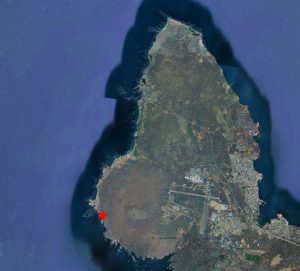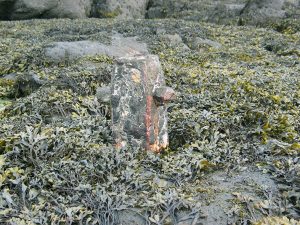German merchants at the trading station of Básendar, Iceland
Bart Holterman, 9 March 2018
The German merchants who sailed to Iceland in the 15th and 16th century used more than twenty different harbours. In this post we will focus on one of them: Básendar. The site is located on the western tip of the Reykjanes peninsula and was used as a trading destination first by English ships, then German merchants from Hamburg and later by merchants of the Danish trade monopoly. Básendar is mentioned in German written sources with different spellings as Botsand, Betsand, Bådsand, Bussand, or Boesand.

Aerial image of Básendar (marked with the red star), located on the Western end of Reykjanes peninsula, and Keflavík airport on the right (image Google Earth).
Básendar was one of the most important harbours for the winter fishing around Reykjanes. In the list of ten harbours offered to Hamburg in 1565, it is the second largest harbour, which annually required 30 last flour, half the amount of Hafnarfjörður (the centre of German trade in Iceland). German merchants must have realised it´s potential at a very early stage, and it is therefore the first harbour which we know to have been used by the Germans, namely by merchants from Hamburg, in 1423.
The trading station was located on a cliff just south of Stafnes, surrounded by sand. Básendar was always a difficult harbour, exposed to strong winds and with skerries at its entrance. Ships had to be moored to the rocks with iron rings. The topography of the site also made the buildings vulnerable to spring floods, and during a storm in 1799 all buildings were destroyed by waves, leading to the abandonment of the place. Today, the ruins of many buildings can still be seen, as well as one of the mooring rings, reminding the visitor of the site’s former importance.
Básendar also became a place for clashes between English and German traders. Already the first mention of Germans in the harbour came from a complaint by English merchants that they had been hindered in their business there. In 1477 merchants from Hull complained as well about hindrance by the Germans and in 1491 the English complained that two ships from Hull had been attacked by 220 men from two Hamburg ships anchoring in Básendar and Hafnarfjörður.
The famous violent events of 1532 between Germans and English started in Básendar as well, when Hamburg skipper Lutke Schmidt denied the English ship Anna of Harwich access to the harbour. Another arrival of an English ship a few days later made tensions erupt, resulting in a battle in which two Englishmen were killed. The events in 1532 marked the end of the English presence in Básendar, and we hear little about the harbour in the years afterwards. The trading place seems to have been steadily frequented by Hamburg ships, sometimes even two per year. In 1548, during the time when Iceland was leased to Copenhagen, Hamburg merchants refused to allow a Danish ship to enter the harbour, claiming that they had an ancient right to use it for themselves.
Hamburg merchants were continuously active in Básendar until the introduction of the Danish trade monopoly, except for the period 1565-1583, when the harbour was licensed to merchants from Copenhagen. From 1586 onwards, the licenses were given to Hamburg merchants again. These are the merchants who held licences for Básendar:
1565: Anders Godske, Knud Pedersen (Copenhagen)
1566: Marcus Hess (Copenhagen)
1569: Marcus Hess (Copenhagen)
1584: Peter Hutt, Claus Rademan, Heinrich Tomsen (Wilster)
1586: Georg Grove (Hamburg)
1590: Georg Schinckel (Hamburg)
1593: Reimer Ratkens (Hamburg)
1595: Reimer Ratkens (Hamburg)
The last evidence we have for German presence in Básendar provides interesting details about how trade in Iceland operated. In 1602 Danish merchants from Copenhagen concentrated their activity on Keflavík and Grindavík. A ship from Helsingør, led by Hamburg merchant Johan Holtgreve, with a crew largely consisting of Dutchmen, and helmsman Marten Horneman from Hamburg, tried to reach Skagaströnd (Spakonefeldtshovede) in Northern Iceland, but was unable to get there because of the great amount of sea ice due to the cold winter. Instead, they went to Básendar which was not in use at the time. However, the Copenhagen merchants protested. King Christian IV ordered Hamburg to confiscate the goods from the returned ship. In a surviving document the involved merchants and crew members told their side of the story. They stated that they had been welcomed by the inhabitants of the district of Básendar, who had troubles selling their fish because the catch had been bad last year and the fish were so small that the Danish merchants did not want to buy them. Furthermore, most of their horses had died during the winter so they could not transport the fish to Keflavík or Grindavík and the Danes did not come to them. The Danish merchants were indeed at first not eager to trade in Básendar, and did not sail there until they moved their business from Grindavík in 1640.
Further reading
Ragnheiður Traustadóttir, Fornleifaskráning á Miðnesheiði. Archaeological Survey of Miðnesheiði. Rannsóknaskýrslur 2000, The National Museum of Iceland.

